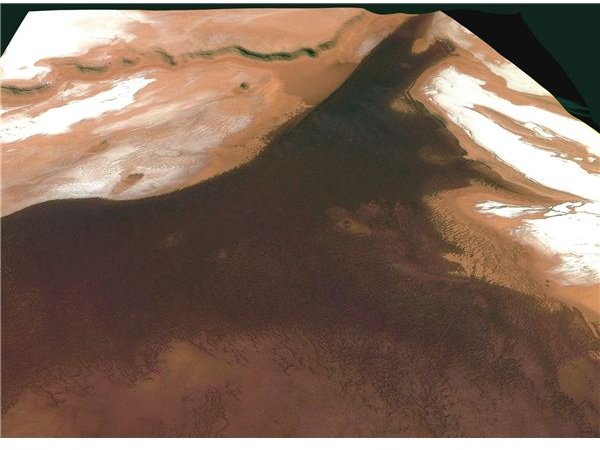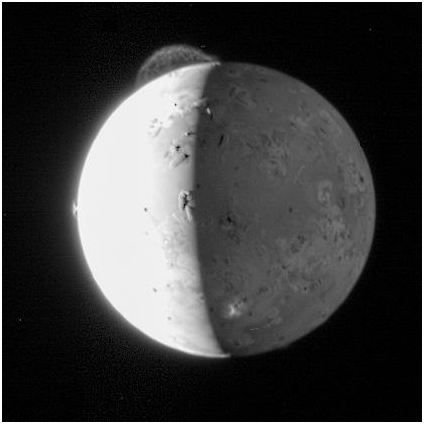Volcanoes in the Solar System: Volcanic Activity on Io, Earth, Triton, Enceladus and Beyond
Io’s Number One!
The most volcanically active body in the solar system, Jupiter’s moon Io shows it with its surface patchwork of silicate magma flows colored by various sulfur compounds. Volcanoes here are powered not by active plate tectonics, as they are on Earth, but by the constant, powerful tidal pull of Jupiter, which lies only 262,032 miles (421,700 kilometers) away. That tug is enough to pull Io’s solid surface up and down by 330 feet (100 meters), which generates a tremendous amount of heat that drives volcanic explosions, gaseous plumes and massive silicate flows.
At its peak, for example, Io’s volcano Loki can pour out up to 1,000 square meters of molten silicates each second. For the time being, that’s enough to qualify it as the most powerful volcano in the solar system.
Above: A gaseous plume created by the eruption of Tvashtar, a volcano on Io. (Image credit: NASA/Johns Hopkins University Applied Physics Laboratory/Southwest Research Institute, https://solarsystem.nasa.gov/multimedia/gallery/PIA09248_modest.jpg)
Meanwhile, Back on Earth
Here on Earth, of course, we have plenty of volcanoes, too. They occur in areas where tectonic plates are either colliding, forcing one plate down under the other to depths where rock is heated enough to melt, or where plates are pulling apart, as they are at our planet’s mid-ocean ridges. Volcanoes can also form when mantle plumes rise up through the crust and form hotspots on the surface; such a hotspot, for example, helped create the Hawaiian island chain.
Our volcanoes can erupt with devastating and deadly force. Some 70,000 to 75,000 years ago, for instance, the Indonesian supervolcano Toba might have exploded with the most power seen in the last 25 million years … enough to wipe out all but a tiny percentage of Earth’s human population. And massive eruptions of the Siberian Traps some 251 million years ago are believed to be one likely cause for the “Great Dying” of so many species during the Permian-Triassic extinction event.
Icy or Extinct (or Maybe Not)

Elsewhere in the solar system, you can find active volcanoes spewing not molten rock but water, methane or ammonia liquids and vapors. These cyrovolcanoes, as they’re called, are found on icy moons that feel the powerful tidal pulls of the gas giants they circle. Cryovolcanoes have been observed on Neptune’s moon Triton and Saturn’s moon Enceladus, and could also exist on Saturn’s moon Titan and Jupiter’s moon Europa.
The Kuiper Belt Object Quaoar could also have cryovolcanic activity, driven in this case not by tidal pull but by heating caused by the decay of radioactive materials.
Other planets and moons in our solar system show signs of volcanic activity in the recent (geologically speaking) past. The number of impact craters visible on Venus’s surface, for example, indicates the planet might have had major makeover thanks to lava flows and other activity some 500 million years ago. Pointing to fast and wild variations in sulfur dioxide levels in Venus’ upper atmosphere, some scientists speculate the planet might still have active volcanoes.
And then there’s Mars. With a surface made up mostly of basalt, the red planet clearly was volcanically active at some point in the past. The peak of that activity came some 3.5 billion years ago, but some volcanism might have continued long after that. Instruments on the European Space Agency’s Mars Express found signs of lava flows as recently as 20 million to 200 million years ago, and discoveries of small amounts of both methane and ammonia in the atmosphere suggest the planet could have life of either the geological or biological kind somewhere.

Above right: A false-color image of Triton, with streaks that might be emissions from small volcanic vents. (Image credit: NASA/JPL, https://photojournal.jpl.nasa.gov/jpegMod/PIA02214_modest.jpg)
Left: This photo taken by Mars Express shows fields of volcanic cones up to 600 meters hight at Mars’ north pole. (Image credit: ESA/DLR/FU Berlin (G. Neukum), https://esamultimedia.esa.int/images/marsexpress/011_Mars_northPole_H_volcanoes.jpe)
